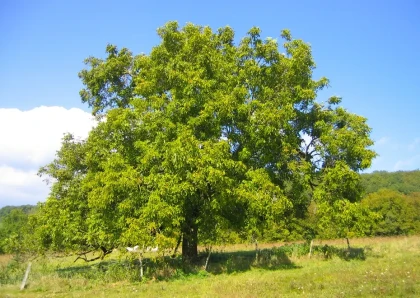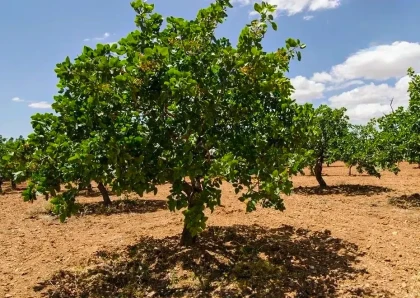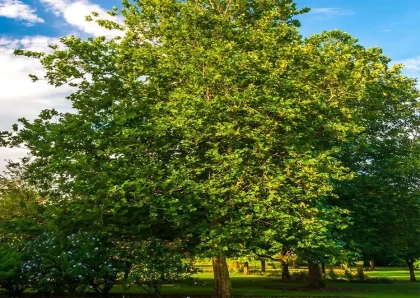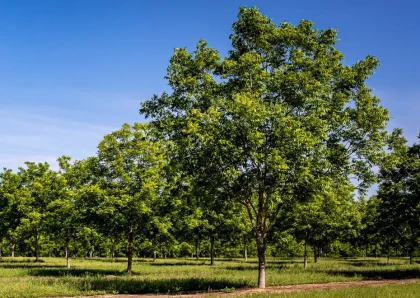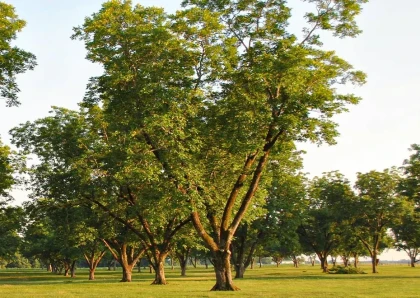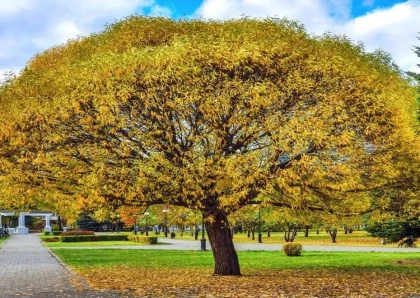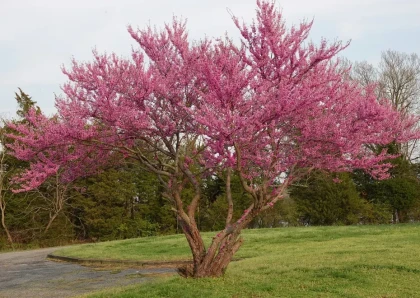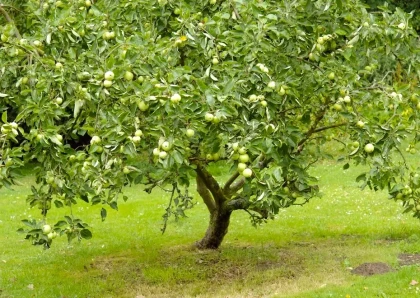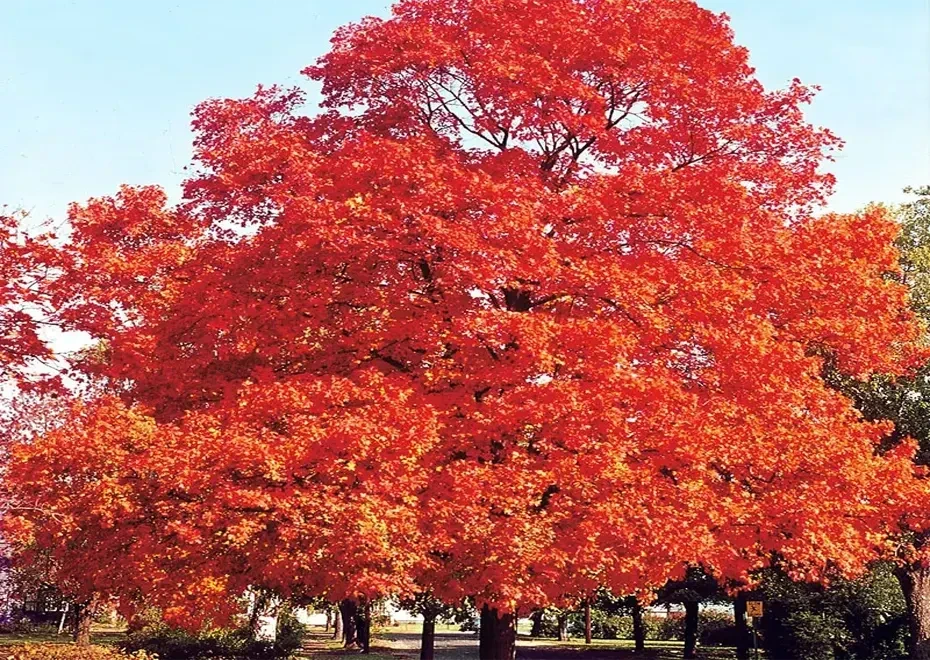
Sugar Maple Tree
Overview
The Sugar Maple Tree (Acer saccharum) is a magnificent deciduous tree that holds a special place in the hearts of many nature enthusiasts and maple syrup lovers. Native to the northeastern regions of North America, including the United States and Canada, this iconic tree is celebrated for its exceptional beauty and cultural significance.
One of the most captivating features of the Sugar Maple Tree is its mesmerizing fall foliage. As the seasons transition from summer to autumn, the Sugar Maple's green leaves transform into a vibrant palette of orange, red, and yellow hues. This breathtaking display of colors has become synonymous with the essence of fall and draws countless admirers to witness its annual spectacle.
The Sugar Maple Tree is known for its robust and sturdy stature, reaching heights of up to 80 feet (24 meters) or more. Its branches spread out widely, forming a broad and rounded crown that provides ample shade and relief during hot summer days. The tree's bark is typically grayish-brown, with deep furrows and ridges that add character to its trunk.
The Sugar Maple Tree is a long-lived species, with some individuals reaching ages of 200 years or more. Its resilience and ability to withstand harsh weather conditions, including cold winters, have earned it a reputation as a hardy and enduring tree. It has become a symbol of strength and natural beauty, deeply rooted in the cultural fabric of the regions it inhabits.
What are the different types of Sugar Maple Tree?
There are two main types of sugar maple:
- Typical sugar maple: This is the most common type of sugar maple. It has a spreading, rounded crown and grows to 60-80 feet tall.
- Dwarf sugar maple: This is a smaller variety of sugar maple that grows to 20-30 feet tall. It is often used as an ornamental tree.
Different types of wood products can be made from Sugar Maple Tree?
The wood of sugar maple is hard and strong. It is used for a variety of purposes, including:
- Sugar Maple wood is highly valued for its strength, durability, and resilience, making it a sought-after material for various woodworking projects.
- The wood's attractive grain patterns, ranging from straight and uniform to occasional bird's eye or tiger stripe figures, add visual interest to furniture pieces.
- Sugar Maple wood is commonly used in the production of high-quality furniture, including tables, chairs, cabinets, and dressers. Its light color and smooth texture create a timeless and elegant aesthetic.
- The wood's density and hardness make it an excellent choice for flooring, providing a durable and long-lasting option for both residential and commercial spaces.
- Musical instrument makers appreciate Sugar Maple wood for its acoustic properties. It is used in the construction of guitars, violins, cellos, and other stringed instruments, contributing to their resonance and tonal qualities.
- The wood's tight and fine grain, along with its ability to take a smooth finish, makes it a preferred material for crafting cutting boards and kitchen utensils.
- Sugar Maple wood's versatility extends to decorative items, such as bowls, vases, and turned objects. Its attractive appearance and workability allow for intricate and artistic designs.
Benefits of Sugar Maple Tree
- Ornamental Beauty: The Sugar Maple Tree is highly sought after for its stunning fall foliage, adding vibrant colors to landscapes and gardens.
- Maple Syrup Production: The Sugar Maple's sap is rich in sugar content, making it a primary source for producing high-quality maple syrup and other maple-based products.
- Shade and Cooling: The Sugar Maple's broad canopy provides ample shade, creating a cool and comfortable environment during hot summer months.
- Environmental Impact: Sugar Maple Trees contribute to the overall health of ecosystems by providing habitat, food sources, and shelter for various wildlife species.
Cons of Sugar Maple Tree
- Space Requirements: Sugar Maple Trees can grow to be large, requiring ample space in landscapes. They may not be suitable for smaller yards or confined areas.
- Fallen Leaves: During the fall season, the Sugar Maple's abundant leaves can create a significant cleanup task. Regular leaf removal may be necessary to maintain a tidy landscape.
Tips for planting and maintaining Sugar Maple Tree
- Location: Plant Sugar Maple Trees in well-drained soil with full sun to partial shade exposure.
- Watering: Provide regular watering during the tree's establishment period. Once established, the tree has moderate drought tolerance but benefits from occasional deep watering during dry spells.
- Pruning: Prune dead or damaged branches during the dormant season to maintain the tree's health and shape.
Conclusion
The Sugar Maple Tree is a remarkable addition to landscapes, offering beautiful fall foliage, maple syrup production, and environmental benefits. Its strong and durable wood is highly valued in various woodworking applications. By following proper planting and maintenance practices, one can enjoy the aesthetic and practical benefits of this iconic North American tree.
FAQs
- Can I tap my Sugar Maple tree for maple syrup?
- How long does it take for a Sugar Maple tree to reach maturity?
- Does the Sugar Maple tree require specific soil conditions?
Yes, Sugar Maple trees are commonly tapped for their sap, which is boiled down to produce maple syrup. However, ensure your tree is mature enough before tapping.
Sugar Maple trees typically take several decades to reach full maturity, but they can provide aesthetic beauty and shade even during their earlier years.
Sugar Maple trees prefer well-drained soil but can tolerate a range of soil types. Ensuring good soil preparation and proper watering are essential for their health.
No listings available
Related Products
Early Elberta Peach
Early Elberta Peach is a highly sought-after peach tree variety that stands out for its remarkable taste and ability to yield fruit earlier than...
Kwik-Krop Walnut Tree
History of the Tree The Kwik-Krop Walnut Tree has a rich history that dates back many decades. Developed by renowned horticulturist Dr. John A....
Famosa Pistachio Tree
History of the Tree The Famosa Pistachio Tree, scientifically known as Pistacia vera 'Famosa,' is a revered variety of pistachio tree with a fascinating...
Columbia Sycamore Tree
Certainly! The Columbia Sycamore Tree (Platanus x acerifolia 'Columbia') is a majestic and highly sought-after deciduous tree. It is a hybrid of the American...
Hardy Giant Pecan Tree
History of the Tree The Hardy Giant Pecan Tree, scientifically known as Carya illinoinensis 'Hardy Giant,' is a remarkable pecan tree variety with a...
Barcelona Filbert Hazelnut Tree
History of the Tree The Barcelona Filbert Hazelnut Tree, also known as Corylus avellana 'Barcelona,' is a popular cultivar of the European hazelnut tree....
Pawnee Pecan Tree
History of the Tree The Pawnee Pecan is a notable pecan tree variety that was developed by researchers at the USDA Agricultural Research Service....
Globe Navajo Willow Tree
The Globe Navajo Willow Tree, scientifically known as Salix matsudana 'Navajo,' is a popular deciduous tree known for its unique and appealing characteristics. This...
Eastern Redbud
The American Redbud Tree (Cercis canadensis) is a charming and versatile deciduous tree that is native to eastern North America. It is widely admired...
Granny Smith Apple Tree
History of the Tree The Granny Smith Apple Tree is a renowned apple variety that originated in Australia in the 1860s. It was discovered...
Questions & Answers
What do you want to know about this product?
Reviews (5)
ChillSeeker83
Shade and Serenity
The Sugar Maple's broad canopy offers cool relief from the summer heat. It provides tranquil shade for outdoor activities and creates a peaceful atmosphere in my backyard.
SyrupMaestro42
Nature's Sweet Symphony
The Sugar Maple's enchanting beauty is matched by the sweetness it provides. From maple syrup to maple-flavored delights, this tree brings joy to my forest and kitchen.
LeafLover99
Fall's Finest Showstopper
The Sugar Maple's breathtaking autumn colors never fail to captivate. Its vibrant foliage paints a picturesque scene, earning it a top spot in my forest favorites.
TimberGuardian17
Strong, Sturdy, and Stunning
As a forester, I admire the Sugar Maple's resilience in harsh conditions. Its robustness, coupled with its magnificent form and exceptional wood, makes it an invaluable tree.
CraftyCarpenter64
Nature's Multitalented Wonder
From furniture to flooring, the Sugar Maple's wood is a carpenter's dream. Its durability, beautiful grain, and versatility make it a prized resource in the woodworking world.






